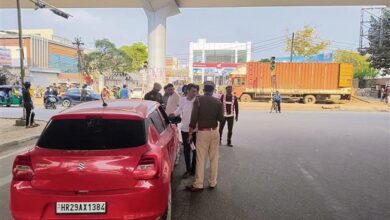Ramification | Bharat Jodo Nyaya Yatra: An Attempt at Unity Has Ended in Devastation
The Bharat Jodo Nyaya Yatra, headed by Rahul Gandhi, came to a close this past weekend. It began in Manipur in January of this year. The final game was played in front of the INDI Alliance leadership at Mumbai’s Shivaji Stadium. The Congress conducted its second outreach, a 63-day yatra, beginning from the east and moving westward this time. But the second yatra was nothing like the first, which attracted the attention of political analysts and the media. The yatra had relatively little effect on the ground, despite the fact that it started in Thoubal, Manipur, and was intended to capitalize on the ongoing ethnic conflicts in the state.

A state wary of the turmoil it had just been through seemed to be trying to avoid making its internal issues political. It is significant, however, that the Meitei lawmakers were urged not to attend the second leg of the yatra, which passed through the Kuki-dominated districts, given the violence and Rahul’s campaigning as the unifier. Numerous Kuki organizations have reportedly requested that Meitei leaders be removed from the yatra when it reaches Sekmai. However, some accounts claim that the Congress leadership requested that Meitei leaders not accompany the yatra outside of Meitei-dominated districts.
In any case, it was clear that Rahul Gandhi was unable to unify two opposing groups under the banner of the Indian National Congress (INC) and a yatra meant to bring the country together.
With little media attention, the yatra continued on to the other Northeastern states, where his road tour was met with, at best, curious rather than fervent devotion. INC lost four seats and was left with only one in Mizoram, which he had visited before the Assembly elections that were conducted in November and December of 2023. It is important to keep in mind that Congress controlled Mizoram for more than 22 years after the state was granted full statehood.
The INC, headed by Rahul Gandhi, has been experiencing a free slide in the Northeastern states. The Northeast Congress used to be in charge or the main opposition in most of the states in the area, but things have changed since then. With a large-scale departure of its MLAs and top leaders, including former Chief Minister Mukul Sangma, to other parties, particularly the BJP, the INC lost Meghalaya and Arunachal Pradesh. With no MLA in the state house, they hardly have any traction in Nagaland. The INC is clinging to a meager 8.56 percent of the vote share in Tripura, where it is in a similar situation. However, in Assam, where the Congress ruled over its people for over 60 years, observers kept a keen eye out for any indications that the INC was still active. And there seemed to be some movement for a brief period.
Videos showing sizable crowds in Dhubri, Assam, were circulated. Compared to the total of the other Northeastern states Gandhi had visited, the optics seemed to be superior. However, word quickly circulated that Badruddin Ajmal, the All India United Democratic Front (AIUDF) president and current Dhubri MP, who has 28 seats in the state, most of which are held by Muslims, was the one who organized the throng. But it was the fact that throngs of Congress workers quit the party—rather than the shifting of blame to Ajmal—that indicated the yatra’s complete failure.
Kamalakhya Dey Purkayastha, the working president of the Assam Congress, resigned and offered his support to the BJP’s Himanta Biswa Sarma, the state’s chief minister. Along with over 150 other Congress workers who joined the BJP in large numbers, Mangaldoi MLA Congressman Basanta Das also backed Sarma. Notable figures who joined the BJP included Angkita Dutta, the daughter of former Assam Congress Committee President and former minister Bismita Gogoi, who went on record as saying that women were unsafe in the Congress after she accused state Congress leaders of making misogynistic remarks. Dutta had also reported Srinivas BV, the president of the India Youth Congress, for harassment. Unfortunately, Dutta was banished.
Not much better was the remainder of the yatra either. Milind Deora, a Congress politician from Maharashtra, left the party when Rahul Gandhi was in Guwahati. His INDI coalition partner, Chief Minister Mamata Banerjee, offered him no support in West Bengal. Her hesitation preceded her decision to contest each of the state’s 42 Lok Sabha seats on her own, without sharing any with the Congress. One of the main INDI alliance partners, the JDU, withdrew when the yatra reached Bihar. As the yatra pushed itself to continue, the chips kept falling. Amidst all of this chaos, Rahul Gandhi, in his own unique way, chose to pull off the vanishing act.
He broke off from the yatra in the middle to attend a series of lectures at the University of Cambridge, only to discover that the invitation was for a paid commercial event in a seminar hall rather than an invitation from the esteemed institution. Considering that it was an external engagement, it is still unclear why the lectures could not have been scheduled for after the yatra ended—a mystery that surrounds many parts of Rahul Gandhi and his yatra.
But the yatra of mistakes has to fulfill its purpose. Pitting himself against Shakti at the Shivaji Stadium in Mumbai last Saturday, Rahul Gandhi made another grave mistake in judgment that marked the end of his yatra. He replied, “Shakti is a word in Hinduism.” We are engaged in combat with a shakti. What exactly is that Shakti, one wonders. This blatant and very insulting assault on the basis of the primary cosmic force in Hinduism shocked the whole nation. Shiva’s spouse, Shakti, is the embodiment of the feminine. Within the “Shaktism” tradition, Shakti is the embodiment of the highest Brahmaan and is worshipped.
Sadly, Rahul Gandhi designated himself as the demonic Mahishasura, who was vanquished by the incarnation of Shakti, Goddess Durga. Rahul Gandhi established the scene and the characters for the impending elections with a single, decisive sweep. After stating that every woman in our nation is an incarnation of Shakti, PM Modi instantly accepted the challenge to vanquish those who oppose Shakti with Shakti. However, it’s possible that Rahul Gandhi had already forgotten the nature of the people and places he had traversed in the Northeast. The majority of women in the Northeast are respected for their strength and independence, and many of the communities there are matriarchal. They don’t tolerate slights well.
At best, the Bharat Jodo Nyaya Yatra was a road trip that did not significantly advance Rahul Gandhi’s leadership position. Additionally, it did not inspire people who may have supported the Congress and the INDI coalition. All is not lost, however; even without Gandhi, the yatra did accomplish something. We were reminded by the 63-day yatra that India is deserving of a stronger opposition. This is not about contrasting the visuals and the mobilization of the first and second yatras, nor is it about Rahul Gandhi and his tendency towards self-destruction. The main issue is that India deserves a stronger opposition that might challenge the current regime and uphold democratic principles in the process.
However, it is fortunate that the Angkitas and Bismitas of Assam are not living through the 56 years of Congress dominance in Assam, with Shakti under fire in the run-up to the 2024 elections. There is still hope for them and those who are similar to them.







